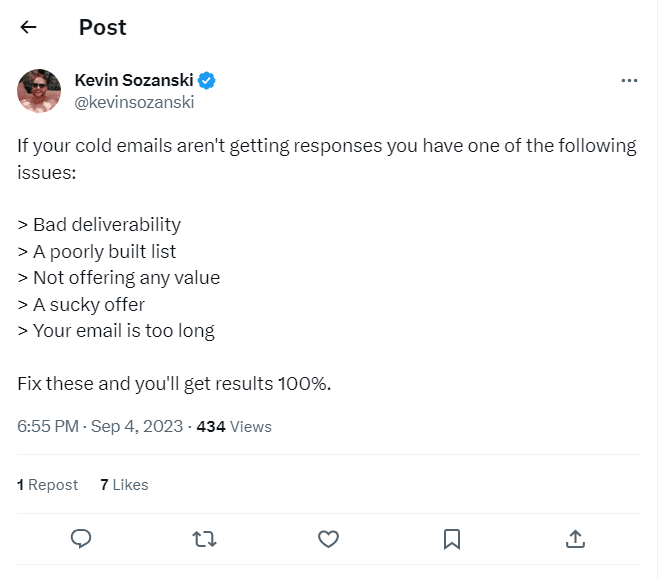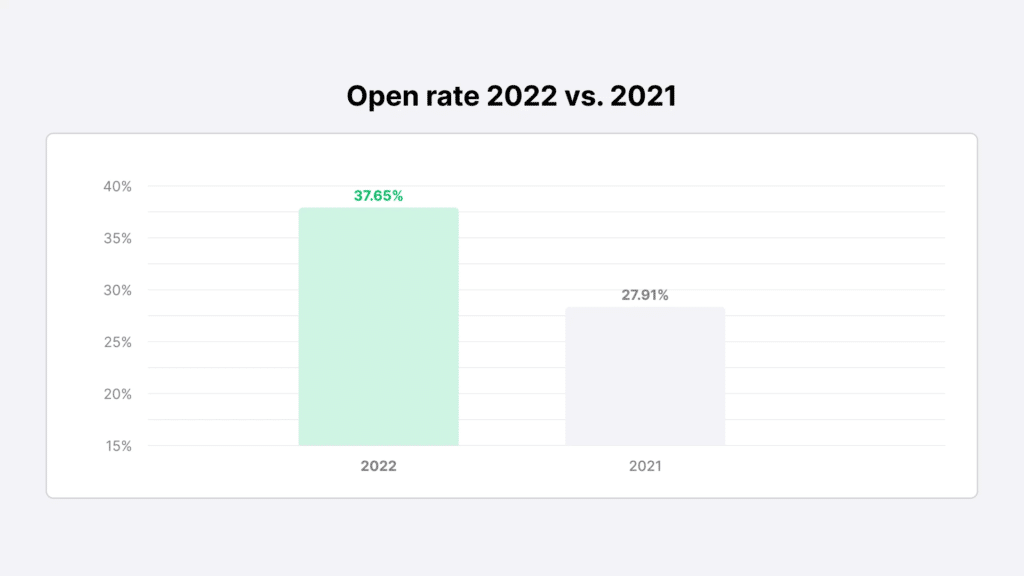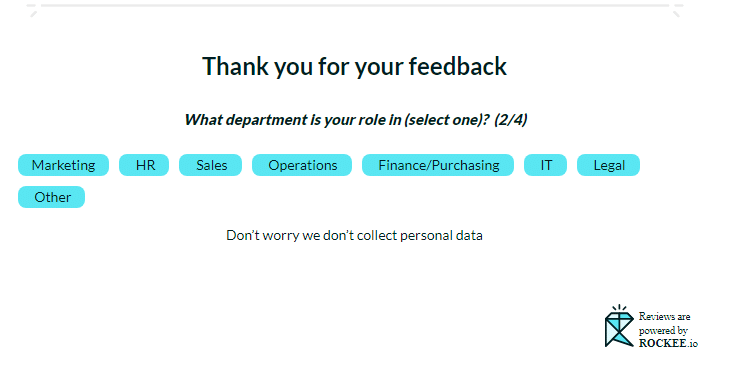How to Improve Email Performance Metrics: 5 Tips to Implement

Unless you live under a rock, you should know what an email is. Heck, you might have sent some emails to your customers today.

(Source)
But how do you know your email campaigns are not only reaching inboxes but also driving results? It all starts with understanding and enhancing your email performance metrics.
In this guide, we’ll discuss:
- How to improve some email performance metrics
- A better way of measuring email content quality
- The power of content feedback in measuring and improving the quality of your email content
What are the key email performance metrics?
Important email performance metrics you should monitor include:
- Deliverability
- Open rate
- Click-through rate
- Conversion rate
- Unsubscribe rate
- Return on investment (ROI)
- Reply rate
5 Tips to improve email performance metrics
1. Deliverability

(Source)
Email delivery and email deliverability are two completely different things. The former refers to the ability of an email to reach the recipient’s inbox, and the latter refers to what happens next. What happens next in this case might be:
- It lands in their primary inbox
- It goes straight to spam
According to Email Tool Tester, 14.3% of all emails go missing or have been caught by popular spam filters while Kaspersky Lab and Cisco Talos place spam emails between 50% and 85% of total worldwide emails sent in a day – above 200 billion – which turns it into a big-scale problem.
To enhance email deliverability, you’ll need to:
- Regularly clean your email list by removing inactive and deleted emails with a tool like NeverBounce.
- Warm new email accounts for 2-3 weeks before increasing send volume: This means gradually increasing the number of emails you send over time for email providers to become familiar with your sending patterns and assess your sender reputation. Both factors significantly impact the deliverability of your emails.
To grow a good reputation that’ll enhance your email’s deliverability, consider implementing some email best practices like:
- Limiting the number of recipients in each email batch to a maximum of 200-300.
- Ensuring a minimum interval of 200 seconds between emails.
- Complying with your Email Service Provider’s (ESP) email sending limits. For example, Gmail allows 500 emails per day for free accounts and 2,000 emails per day for a paid Google Workspace account.
- Restricting the number of recipients from the same organization to a maximum of 5.
Though it’s a time-consuming process, Email warm-up is essential for effective email marketing, especially when you’re using a new email address and domain. To simplify this process, consider using automated email warm-up solutions like Litmus and Folderly.
2. Open rate

(Source)
Once your email lands in the recipient’s inbox, the next step is getting them to open it. Notably, the current average email open rate hovers around 37.65%. Moreover, a recent survey by SuperOffice revealed that 33% of respondents open emails solely based on the subject line.
To boost your email open rate:
- Personalize: Including the recipient’s first name, for example, increases email open rate by 2% according to GetResponse.
- Conduct A/B tests to determine which subject lines generate higher open rates.
If no one opens your email, you aren’t getting any clicks, which brings us to the next tip.
3. Click-through rate
Click-through rates measure the percentage of people who click on a link or a call-to-action in your email. According to Mailchimp, the average email click-through rate across all industries is 2.62%.
To improve your email CTR:
- Experiment with email templates and layouts because email design affects how users interact with your message, as well as their level of interest and engagement. You can also test different email designs to find out what works best for your audience.
- Customize the content to match your email list. For example, for a newsletter, you can send longer emails. For product-focused content or offers – prioritize a single call-to-action (CTA).
- Include visuals in your emails to enhance their appeal and convey your message more effectively. However, when including images, make sure to assess their compatibility and loading speed on different devices.
According to a case study from Campaign Monitor, using an image-based email design can increase click-through rates by 127%.
A good email layout should:
- Adapt to different screen sizes and devices.
- Be easy to scan with clear headings, bullet points, and white space.
Test different email templates and content layouts to analyze which combination of these factors works best for your goals and audience.
4. Focus on content quality
Content quality here means sending the right emails to the right people – to answer the right questions.
To ensure your email content is of high quality:
1. Segment your email list
According to HubSpot, marketers who segmented their email lists experienced as much as a 760% increase in revenue. Matching content to subscriber intent:
- Increases email relevance/content quality
- Reduces bounce rate
- Increases the conversion rate of your email campaigns
Segmenting your email list offers multiple advantages. Firstly, it enhances the precision of your content. Secondly, sending emails to targeted groups improves email deliverability, as spam filters frequently block senders who dispatch a high volume of emails all at once.
2. Test different offers
You can test different offers inside an email by comparing two versions that have different incentives or calls to action, such as discounts, free trials, or bonuses. The goal is to find out which offer generates the most engagement and how you can create content around it.
5. Improve your measurement of email content quality
Measuring the quality of your email content is somewhat subjective, but you can use some key indicators to gain a better understanding of how warm your email list is. Here are some indicators to analyze:
Unsubscribe Rate: A rising rate may indicate that your content isn’t resonating with your audience, or it might be a sign of list fatigue – where the interest of email subscribers begins to decrease.
Open Rate: Monitoring the open rate will provide insights into the attractiveness of your subject lines.
Click-Through Rate (CTR): CTR reveals how effective your email content is at driving actions. It’s a critical metric for assessing the relevance of your email content.
The challenge arises when you observe a downward trend or stagnation in these metrics. This is where context becomes important.
Putting It All Together: Email Performance Insights
To gain a deeper understanding of what’s happening, consider using Rockee’s feedback landing page for the following:
Customized Questions: To identify your readers and their preferences – to help you refine your email content further.


A Feedback Box: To encourage subscribers to comment or offer suggestions. This direct method helps in collecting qualitative data on content quality.

iManage, a b2b tech company, directs readers from their prospecting and customer monthly newsletters to a Rockee feedback landing page as a way of monitoring if the content is of sufficient quality for their audience.
Using audience feedback alongside quantitative metrics would help you measure the effectiveness of your email content in a much better way – by giving you context behind the numbers. Ask your audience if they love your emails – with Rockee.
How to improve email performance metrics (FAQs)
How can I improve my email performance metrics?
To enhance your email performance metrics, focus on optimizing subject lines, personalizing content, segmenting your audience, collecting feedback, and regularly testing and analyzing your email campaigns.
How can I effectively measure and improve email content quality?
To measure content quality, use metrics like content ratings, CTR, and unsubscribe rate. You can collect insights – using Rockee – directly from subscribers to improve the quality of your email content.
